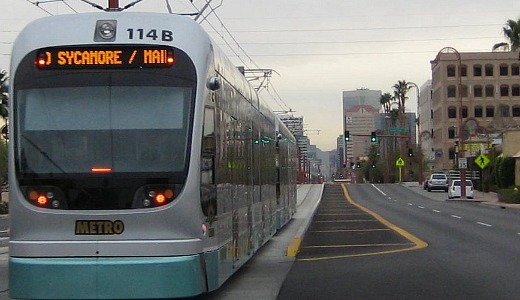
A new study from the Apollo Alliance finds that comprehensive energy and climate policies, and a focus on infrastructure spending on clean transportation, could create 3.7 million jobs in the U.S., including 600,000 in manufacturing over the next six years, if their recommended Transportation Manufacturing Action Plan (TMAP) is passed.
The Apollo Alliance is a coalition of labor, business, environmental and community leaders advancing a vision for the next American economy centered on clean energy and good jobs.
United Steelworkers President Leo Gerard joined the alliance at a news conference last week, and said: “This is an opportunity to rebuild the important transportation infrastructure of this country and to put it in a first class system, The additional benefit we can call the triple bottom line. We get to create good family-supporting jobs, we get to spend dollars in a way that is going to grow the economy but just as importantly, we take carbon out of the air.”
Inaction on President Obama’s already proposed infrastructure plan, and associated bill, has already cost 88,000 jobs this year in Missouri alone, the alliance noted in an earlier press release.
Missouri is just one of many states that would greatly benefit from the president’s re-articulated call for a complete “infrastructure overhaul,” also announced last week. It includes a $50 billion investment in roads, bridges, railways and electric grids that Obama says are “woefully” inadequate.
The president’s comments came Oct. 18 after a meeting with Cabinet officials, governors and mayors, where they discussed a new government report that says a significant infrastructure improvement effort could help create jobs and boost economic output. Obama proposed a six-year plan that would rebuild and modernize hundreds of thousands of miles of roads, bridges and rail lines as well as overhaul the way the government funds such projects.
The government report also has some new thinking about public-private partnerships to expand the total amount of directed infrastructure investment.
Placed in the context of possible paralysis in the next Congress on additional stimulus, the government report’s emphasis on mobilizing more private capital to meet the scale of infrastructure improvements required is timely, but also complicating. Which “green” technologies, which mix of short- and long-range interests will be promoted over others? The choices may be strongly influenced by the private partners.
It’s not surprising that some resist, even extremely so, anything to do with “clean” or “green” technology subsidies, or mitigating the human impact on climate change, or for that matter anything threatening the monopolistic, private, corporate structure of the current energy industry.
Privatizing some of the capital inputs into public or quasi-public utilities and infrastructure may help speed the desired overall technological re-allocation of capital by overwhelming the resistance of the old with opportunities for the new. With more room to expand, there may be fewer overall losers letting off steam.
It may be the only way to go, but a price will be paid. In a sense the government will be placing a very strong bet on the markets. But the government initiative will be vulnerable to capture by the monopolies it is trying to restructure. Public transparency will be required in order to minimize this danger.
Both the Apollo Alliance and the government report to the president call for a National Infrastructure Bank, a big step toward a transparent, real national industrial policy that can mobilize both public and private resources.
The government report says: “Not all infrastructure projects are worth the investment … The establishment of a National Infrastructure Bank would create the conditions for greater private sector co-investment in infrastructure projects. A National Infrastructure Bank would also perform a rigorous analysis that would result in support for projects that yield the greatest returns to society and are most likely to deliver long-run economic benefits that justify the up-front investments.”
The bank’s job is to insure against expensive roads to nowhere
For all the current complaints heard from some quarters about China’s “unfair subsidies” to their industries, there is a complementary argument that stronger and smarter subsidies of the Chinese variety are necessary here to secure our own sustainable future through what is clearly a deep and structural crisis in class and industrial relationships within U.S. society.
Publicly sponsored or partnered capital projects (like rails, airports, roads, etc.) can return in value many times their cost. Both the Alliance and government reports document the major positive impact of “smart” investment in transportation, health care, and “green” industries on the cost of living for working families. Transportation/commuting costs in particular are the number two expense for most families, just below housing, according to the Bureau of Economic Analysis (BEA). Thus bonds (debt) sold to fund capital transportation investments are a pretty good bet to pay off in substantially reduced transportation cost per family, and thus should raise wealth and reduce long-term debt.
The establishment of a National Infrastructure Bank would certainly require congressional action. The truth is: the Republicans will oppose it on principle as “more socialism.” They would be right. It is “more socialism.” The alternative is continued instability, aggravated inequality rivaling India or Pakistan, and continued relative decline in U.S. economic performance and standard of living.
Unfortunately, until something is done in the short range about 10-percent-plus unemployment, there is not likely to be a lot of long-range thinking predominant in Washington, or anywhere else. There are three possible approaches:
1. Cut through the red tape and make as many of the infrastructure projects “shovel ready” as possible. Focus on funding these. But it won’t be enough to dent short-range unemployment sufficiently. For youth and seniors – including those laid off within a few years of Social Security, millions of whose pensions and retirement savings have been lost – the government must become the employer of last resort through national, state and local service programs. Those programs also should also undertake contributions toward infrastructure, as they did in the 1930s, where the products are public goods or necessary goods and services which markets can’t or won’t provide. These WPA-style programs do not create deficits, nor are they inflationary. At the same time they substantially improve the bargaining power of workers in all labor markets, especially in times of high unemployment.
2. Adopt the Republican approach: “the hungry dog hunts harder.” End unemployment extensions. Cut the minimum wage. Privatize Social Security. The “market” will find the appropriate minimum wage. You want to retire? Save on your own – why should we help you? This is the class warfare proposal.
3. Attempt to maintain the status quo: pass the unemployment extension, play defense on the Republican attacks. Ten percent or worse unemployment remains. Unfortunately this could be the road to nowhere.
The first choice seems the best. It simply gives us the stability to focus on infrastructure, on a sustainable future. As poet Naomi Nye says, “It’s late – but everything comes next”. From where we are now, infrastructure is the road to anywhere, and everywhere.
Photo: Light rail line in Phoenix. (Phil Sexton/John Hall & Associates cc 2.0)












Comments